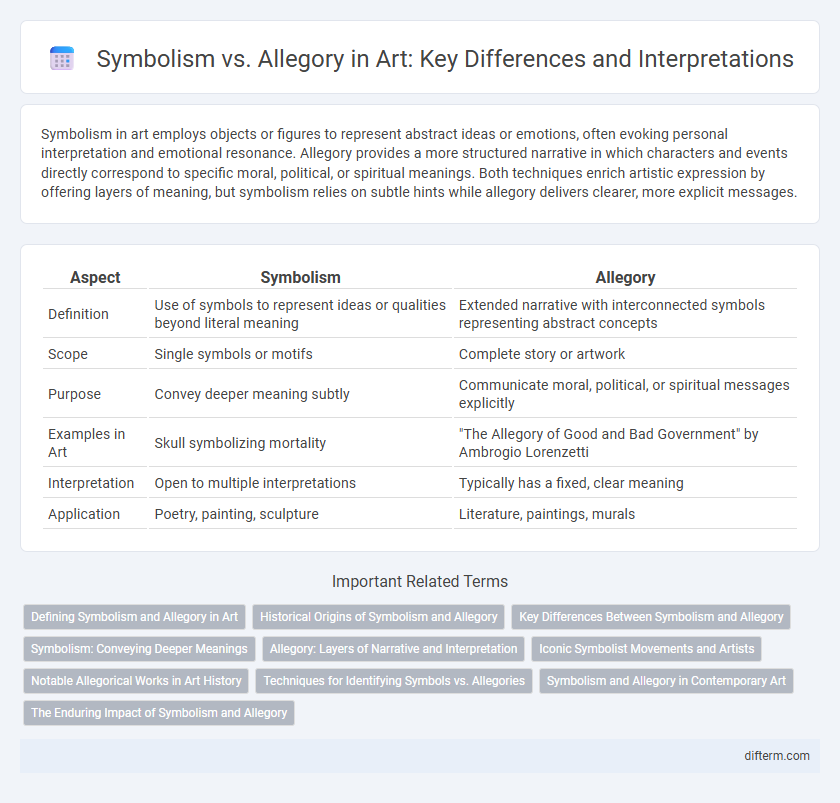Symbolism in art employs objects or figures to represent abstract ideas or emotions, often evoking personal interpretation and emotional resonance. Allegory provides a more structured narrative in which characters and events directly correspond to specific moral, political, or spiritual meanings. Both techniques enrich artistic expression by offering layers of meaning, but symbolism relies on subtle hints while allegory delivers clearer, more explicit messages.
Table of Comparison
| Aspect | Symbolism | Allegory |
|---|---|---|
| Definition | Use of symbols to represent ideas or qualities beyond literal meaning | Extended narrative with interconnected symbols representing abstract concepts |
| Scope | Single symbols or motifs | Complete story or artwork |
| Purpose | Convey deeper meaning subtly | Communicate moral, political, or spiritual messages explicitly |
| Examples in Art | Skull symbolizing mortality | "The Allegory of Good and Bad Government" by Ambrogio Lorenzetti |
| Interpretation | Open to multiple interpretations | Typically has a fixed, clear meaning |
| Application | Poetry, painting, sculpture | Literature, paintings, murals |
Defining Symbolism and Allegory in Art
Symbolism in art employs individual objects or images to represent broader ideas, emotions, or themes, allowing viewers to interpret meanings beyond the literal appearance. Allegory uses a structured narrative or composition where characters, events, and details collectively convey a moral, political, or spiritual message, often unfolding a story with multiple layers of interpretation. Both techniques enrich artistic expression by embedding deeper significance within visual elements, but symbolism tends to be more abstract while allegory is more explicit and narrative-driven.
Historical Origins of Symbolism and Allegory
Symbolism originated in the late 19th century as a reaction against realism, emphasizing the use of symbols to express mystical and emotional experiences. Allegory dates back to ancient Greece and Rome, where it was employed in literature and art to convey moral, political, or spiritual messages through extended metaphorical narratives. Both techniques serve as tools for artists to communicate complex ideas, but symbolism leans towards abstract representation while allegory relies on structured storytelling.
Key Differences Between Symbolism and Allegory
Symbolism uses individual symbols to represent ideas or qualities, often allowing multiple interpretations within a single artwork. Allegory conveys a broader, cohesive narrative or moral lesson through a series of interconnected symbols and characters, making its intended message more explicit. While symbolism invites personal reflection, allegory delivers a structured, didactic meaning.
Symbolism: Conveying Deeper Meanings
Symbolism in art employs icons and motifs to represent abstract ideas, emotions, or concepts, enabling viewers to grasp deeper meanings beyond the literal representation. Unlike allegory, which typically uses a structured narrative to convey moral or political messages, symbolism relies on subtle visual cues and metaphors that evoke personal interpretation. This technique enriches artworks by layering multiple levels of significance, engaging the audience in a contemplative experience.
Allegory: Layers of Narrative and Interpretation
Allegory in art unfolds through multi-layered narratives that convey abstract ideas and moral lessons using symbolic figures, actions, and imagery. This technique invites viewers to engage deeply with the artwork, unraveling complex interpretations beyond surface aesthetics. By embedding hidden meanings within a structured storyline, allegory transforms visual art into a powerful medium of ideological and philosophical expression.
Iconic Symbolist Movements and Artists
Symbolism in art emphasizes conveying emotions and ideas through icons and motifs rather than direct narrative, distinguished by movements such as the French Symbolists led by Gustave Moreau and Odilon Redon. Allegory involves explicit storytelling with characters and scenes symbolizing broader moral or political messages, exemplified by artists like William Blake and Sandro Botticelli. Key Symbolist artists prioritized mystical, dream-like imagery to evoke deeper psychological states, influencing later movements including Art Nouveau and Surrealism.
Notable Allegorical Works in Art History
Notable allegorical works in art history include Sandro Botticelli's "Primavera," which uses mythological figures to represent themes of love and renewal, and Pieter Bruegel the Elder's "The Triumph of Death," symbolizing the inevitability of mortality through an elaborate landscape of death and chaos. Hieronymus Bosch's "The Garden of Earthly Delights" stands out as a complex allegory of human sin, temptation, and ultimate judgment. These masterpieces employ detailed symbolism to convey moral, philosophical, and cultural messages beyond their literal appearances.
Techniques for Identifying Symbols vs. Allegories
Techniques for identifying symbols involve analyzing individual elements within artwork that represent broader concepts or ideas, often through color, shape, or recurring motifs. Allegory requires recognizing the narrative structure where multiple symbols work collectively to convey a deeper moral, social, or political message. Interpreting symbolism focuses on singular visual cues, while deciphering allegory demands understanding the interconnectedness of symbols within the entire composition.
Symbolism and Allegory in Contemporary Art
Symbolism in contemporary art uses specific images, colors, and forms to evoke deeper meanings and emotional responses, often drawing from personal or cultural motifs. Allegory extends beyond symbolism by constructing entire narratives or scenes where characters and events represent broader ethical, political, or social concepts. Contemporary artists blend these techniques to address complex themes, enriching viewer interpretation and engagement.
The Enduring Impact of Symbolism and Allegory
Symbolism and allegory both serve as powerful artistic devices that convey deeper meanings beyond the literal, with symbolism often relying on individual elements representing abstract ideas, while allegory uses a sustained narrative or image to communicate a broader message. The enduring impact of these techniques is evident in their ability to evoke emotional responses and provoke critical reflection, transcending cultural and historical contexts. Masterpieces employing symbolism and allegory continue to influence contemporary art by inspiring interpretation and dialogue, highlighting universal human experiences through layered visual language.
symbolism vs allegory Infographic

 difterm.com
difterm.com